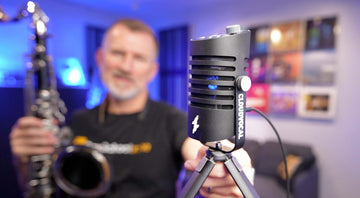
A detailed instruction for violinist and fiddlers
If you are confused about what hardware to use for your gigs and recording sessions, then you should spend some time on this article. Our veteran performer Matt Bell will guide you from the basics to the pros and cons of pickups available in the markets in this section.
“Working with” a sound, what does that mean?
When we say “working with” a sound, it means that we can manipulate the signal to try to make it sound more natural. One tool is that we can adjust the frequency balance (or EQ) of a signal. Many signal processors have high, medium, and low frequency controls. Turning up the high frequencies makes a signal sound brighter and crisper. Turning down the high frequencies makes a signal less shrill or biting. Turning up medium frequencies (or “mids”) makes a signal sound fuller or fatter. Turning down the mids makes a signal sound less muddy.
We can also add reverb to a signal. Reverb is the sound you hear when you’re in a hall or a cathedral and you play a short note and stop. You can hear the note reverberating in the room for a while. We can add artificial reverb to a signal to make it sound like you’re playing in a nice room. Too much reverb can sound washy or indistinct. Too little reverb can sound dry or close. Pickups tend to need more EQ and reverb than microphones, so if you’re using a pickup, just be prepared to spend a little more time experimenting to get your sound how you want it.
Now you know how to decide whether you need a microphone or a pickup in a given situation. But there are lots of different microphones and lots of different pickups. Which one is best? Again, it depends on your situation. I find it’s best to learn what the pros and cons are for each type of mic and pickup, then you can make the decision about what’s best for you.

There are two general classes of pickups: removable and permanent.
Most violin pickups are piezo pickups. A piezo pickup operates on the scientific principle that many crystals generate an electrical signal when you subject them to a physical stress. If we embed a solid crystal in a violin bridge, when the bridge vibrates, the crystal generates an electrical signal at the same frequency as the vibration. You can run a cable from your pickup to an amplifier or a sound system and that signal can be amplified and/or recorded.
A removable pickup is exactly what it sounds like. The pickup and jack can be installed on the instrument easily in a very short period of time – maybe a minute or two – and can be removed just as quickly. This allows you to use your main instrument both for gigs that don’t require amplification and those that do.

A permanent pickup is one that would be installed on the instrument by a luthier and would need to be removed by a luthier. The most common type is a replacement bridge. This is a special bridge that has a pickup embedded in it. There will be a jack that will be clamped onto your instrument and would need to be left there. If you only use your instrument for amplified gigs, this is an excellent choice, as you won’t have to install and remove your pickup every time you play. Schatten and Barcus-Berry are common replacement bridges.
We’ve used another term here that you may not be familiar with: jack. In the amplified music world, we use cables to connect instruments to sound systems. The convention is for instruments to have a female connection (a jack) for the male end of a cable to plug into. The standard instrument cable is a ¼” (6.3mm) male-to-male cable. The jack will generally be in a plastic or wood housing that clamps to your instrument with the same type of clamp used to hold your shoulder rest on. If you’re going to be installing/removing a pickup and jack, make sure you have the proper tool for the clamp so you don’t damage your instrument.
For removable pickups, there are a lot of options. Some insert into the wing slot of the bridge (Kremona, Fishman, and Schertler are common brands). Some clamp onto the side of the bridge (Barcus Berry is a common brand). Some are wrapped around the body of the instrument (The Band is a common brand). Some clamp inside the F hole (Realist is a common brand). Some attach to the back of the violin with a sticky putty (Schertler is a common brand). Some are placed under the bridge (Realist is a common brand).

Pickups that insert into the wing slot (Kremona)


Pickups that clamps onto the f hole (Realist)

Take these into consideration: price and ease of installation
You can find very cheap pickups for just a few dollars. We recommend avoiding those as you get what you pay for. You practice too hard to trust your sound to a $10 pickup. The lowest cost pickup a reputable shop would recommend will be in the $90-100 range. Really expensive pickups can cost around $500 and need to be custom fit. Remember that your sound is only as good as the worst component in your signal path. So if you want high quality sound, you’re going to want high quality gear. However, if you don’t play a lot of amplified gigs and they don’t make a significant portion of your income, it can be hard to justify buying the most expensive pickup available. A lower cost ($100-200), yet still professional quality, pickup might be the answer.
Another factor to consider is how complicated it is to install or remove the pickup. A simple clamp on the side of the bridge is quite easy. A pickup that slides into the wing slot of the bridge is also easy (Assuming your wing slot is big enough. Sometimes, you’ll have to re-shape that wing slot – or have a luthier do it – for that type of pickup to work.) Installing a pickup under your bridge requires you to loosen your strings and raise up the bridge (preferably with a bridge jack to prevent your sound post from falling). Also, the more complicated it is to install your pickup, the more variable your results are going to be. If you don’t get the pickup in exactly the same place each time, your sound could be different each time.
The sound of the pickup is also important. Tone is a very personal and subjective thing and each type of pickup sounds different. What sounds good to you may not sound good to me. We all have our own preferences. Some people like a bright, crisp sound. Others want a dark, warm sound. It also depends on what your instrument sounds like. A dark sounding pickup on a dark instrument might sound mushy and indistinct. A bright sounding pickup on a bright instrument could be shrill and painful. So you’re looking for a nice pairing of tones in a price range that makes sense for you and with an installation process you’re willing to live with. Because each player, instrument, and situation is different, if you’re not sure, it might good to chat with a professional before making a final decision.
Also you can check out the link for the pickup reviews.

WRITTEN BY
Matt Bell
Matt has started playing classical violin at the age of 3. As a teenager, he discovered rock and roll and began to explore the collision of those two worlds. After 20 years of touring all over the world, Matt have developed his own unique style. His latest project shows that VIOLINS CAN ROCK!






